Potsgrove Church Alterations and Additions
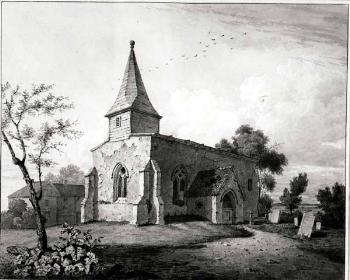
The church about 1820 [Z103/1]
Most of the structural history of the church can be found in detail in Bedfordshire Historical Record Society Volume number 77 of 1998 Bedfordshire Churches in the Nineteenth Century: Part II: Parishes H to R, put together by former County Archivist Chris Pickford from numerous sources some held by Bedfordshire & Luton Archives & Records Service and some held elsewhere or published.
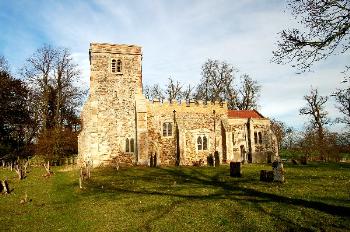
Battlesden church January 2007
In 1732 the benefice of Potsgrove was united with that of Battlesden and in 1775 it was suggested that one of the churches be pulled down, fortunately the proposal was resisted by both congregations so both churches remain today [2013]. Repairs were undertaken at Potsgrove shortly after the suggestion to demolish was defeated. One of the bells was recast in 1743 and another in 1813.
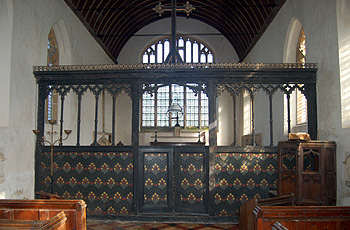
The rood screen February 2012
It is known that much of the 14th century stained glass was intact at the beginning of the 19th century. The rood screen was in place and the Saunders brasses were still whole and in their original places in the floor of the nave (by 1947 they were on the north wall of the nave). The old font was at the back of the church and there were private, enclosed pews at the front. The nave roof was leaded and was lower than that of the chancel, which was tiled. The west end sported a low, wooden bell turret. Several of the nave windows were partially blocked by masonry.
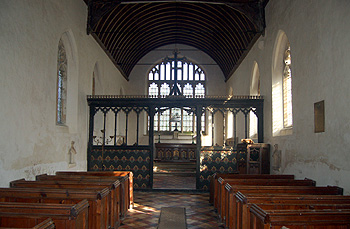
The interior looking east February 2012
In 1823 Archdeacon Bonney ordered the church to be restored including un-bricking and glazing the east window and colouring the brick work in the side windows of the chancel to imitate glass. In 1833 he ordered that the green moss be brushed off the interior, showing how neglected the church had become.
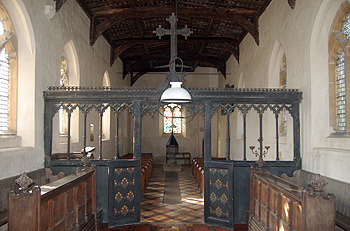
The interior looking west February 2012
We have a snapshot of the church in the mid 19th century courtesy of WA, pseudonym of John Martin, librarian of Woburn Abbey. He wrote descriptions on all Bedfordshire churches for the Northampton Mercury. Martin was a pompous, opinionated man and his descriptions are usually full of vituperation and sarcasm. He wrote about Potsgrove in the edition of 18th June 1845.
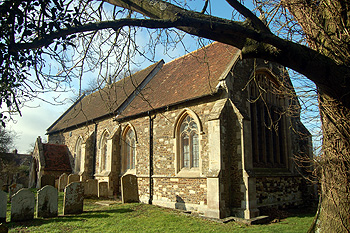
The church from the south-east February 2012
“This church is a very melancholy spectacle of injury and neglect. It has been so sadly used that it is almost difficult to point out the abuses. The external condition is very deplorable, and unless means are soon taken to arrest the decay actively going on, it will soon be numbered among the things that were. The effect of the progress the weather is making externally, is strikingly evinced by the internal state of the building. The interior is of a very bad character: it is true a wooden roof remains, but from the inspection we had time to make, it seemed to be a substitute some years ago for one of a higher quality. Four select square pews, painted and varnished were happily all that had yet found a habitation here. The rest were all open seats, not very good, but excellent compared to some recently erected, in miserable taste. No traces were perceptible of the western entrance, which years ago, it would appear, had been effectually swept away. The font remained in its right position, although the approach to it in the proper way had been done away. Some bricks were carefully piled up, with a besom and broom, under the western window; a disgusting abuse. The chancel was a very paltry affair; a ceiled roof – miserable altar-rails – two side windows blocked up, which, in addition to disfiguring the interior, made the external appearance of the church more offensive. The churchyard was in a neglected state, rendered more so by the admission of sheep. A miserable building adjoining was said to be the Parsonage-house. It is almost superfluous to add it was unoccupied”.
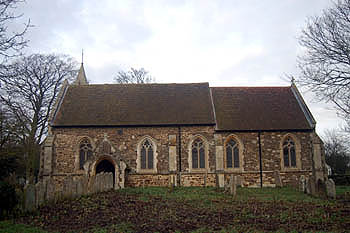
The church from the south January 2008
Someone calling himself “A Constant Reader” took exception to some of Martin’s criticisms. He wrote a letter published in the paper on 12th July: “…with respect to Potsgrove church, I think your correspondence [sic] was rather severe in his criticisms; nothing can be said in favour of the chancel, which has been lately put into its present state, and is truly hideous; but the church itself, I believe, remains very much in its ancient state, and has suffered less from the hand of improvement than most churches; the stone mullions remain in the windows, which are very beautiful, although the painted glass, for which this church was once celebrated, has long since mostly disappeared. As the lead has not been removed, it may be inferred that the old roof, though not of a high character, still remains”.

The church from the west February 2012
“There is certainly no mark of a western entrance, and I think your correspondent is mistaken in supposing that there ever was one, or that a western entrance was ever universal”.
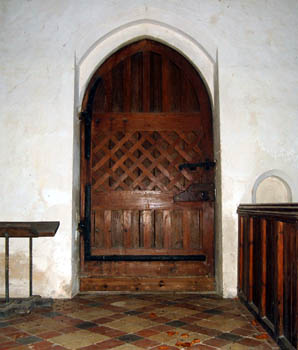
The north door January 2008
“The church-yard, which I have often noticed, is generally in quire as good order as church-yards usually are; sheep are certainly admitted, but by the express permission of the archdeacon; and here it may be remarked that churchwardens are often blamed when the rector or archdeacon is in fault, as they act under the eye of the rector, or by order of the archdeacon, therefore ”Palmam qui meruit ferat”, anglice, “Clap the saddle on the right horse. The parsonage house is very accurately described by your correspondent”. A new parsonage was built in 1889.
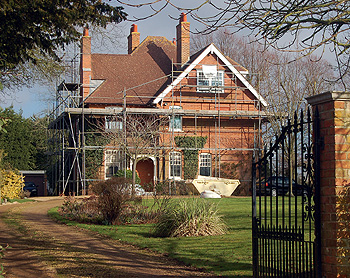
The Old Rectory February 2012
The major restoration took place under Rev. E. Norman Coles, rector from 1857 to 1888. One of his first acts as incumbent was to build a school-church in Sheep Lane as the population there was now larger than in the village itself, this chapel was known as Saint John's. In 1875 Archdeacon Bathurst described Saint Mary's as "in very poor condition" and Coles undertook its restoration the work being carried out in 1880 and 1881 by the architect John Dando Sedding.
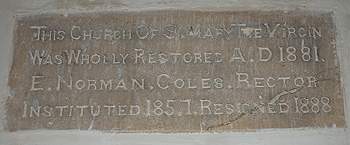
Plaque regarding the restoration of the church February 2012
Sedding was connected with the Arts and Crafts Movement. Nothing, perhaps, better illustrates this than the painting of the rood screen.
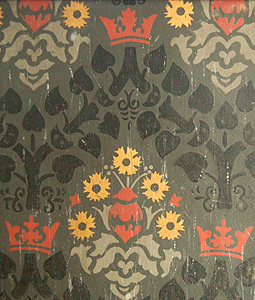
Detail of the rood screen February 2012
Sedding’s work was thorough, Christopher Dalton describing it, in a leaflet he wrote for the Redundant Churches Fund as extensive and most effective. One of the external signs of his work is the octagonal stone belfry and spirelet, replacing the old wooden turret, on the north side of the west end. It contains three bells of the 17th century, 1743 and 1813.
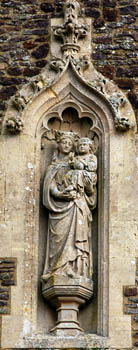
Madonna and Child at west end January 2008
The other sign is the Virgin and Child in the exterior of the west wall. This is a handsome piece and very appropriate for a church dedicated to Saint Mary.
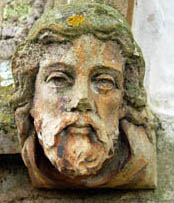
The corbel head to east of north door January 2008
Sedding rebuilt the south porch, re-using some of the old material. A whimsical note is that the badly eroded stone heads on either side of the doorway represented the Bishop of Ely and Rev. Coles! The carved heads either side of the north door are Jesus and the Virgin Mary. Sedding also provided new north and south doors.

The west window February 2012
Sedding was responsible for collecting the fragments of 14th century stained glass and using them to fill the west window. The font, made of Cornish serpentine, with a painted wooden cover, was also made for and installed by him.
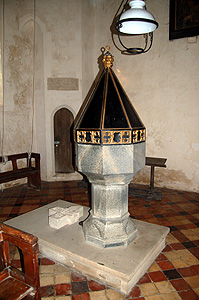
The font February 2012
A high pitched roof was added to the nave in 1880, making it higher than the chancel. The pews and pulpit were installed in 1880.

The pulpit February 2012
Another feature of 1880 is the east window, though it copies a 15th or early 16th century original. Also in the chancel are the 1880 choir stalls.
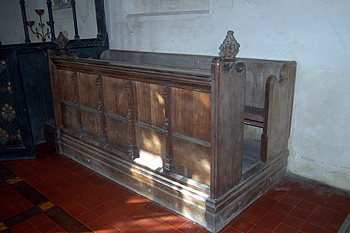
The choir stalls on the north side of the chancel February 2012
The tomb recess was greatly restored by Sedding. He also added the stone canopy above the sedilia in the south wall.
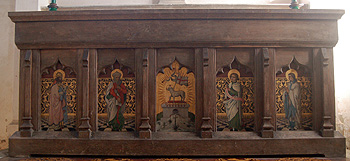
The altar February 2012
The 1880 altar is memorable. It has paintings depicting, left to right, Melchisedec, Abraham, Saint John and a priest contemporary with the restoration. The lychgate also dates from 1880.
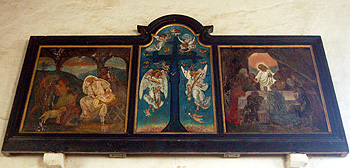
The former reredos over the north door February 2012
The former reredos, introduced into the church after the restoration of 1880 is now above the north door. It shows the Nativity, the Crucifixion and the Last Supper.
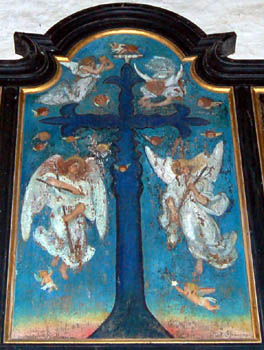
Central panel of the former reredos January 2008
The stained glass in the south wall west window was brought from the former Saint John's. Christopher Dalton describes it as "mediocre stained glass of the mid-Victorian period".
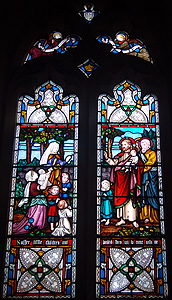
The south wall west window February 2012
Another later addition is the handsome war memorial. the brass tablet is affixed to the south wall of the nave.
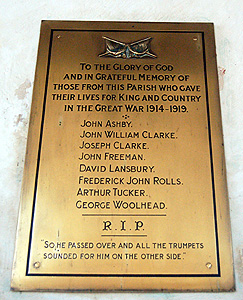
The war memorial February 2012
As early after restoration as 1894 structural problems were noted with the church and these concerns led to its closure in 1966 and approval for demolition in 1968. Fortunately the church was, for the second time, spared this ignominious fate and was given over to the Redundant Churches Fund (now the Churches Conservation Trust) in 1972. The building is now structurally secure and may be visited, a worthwhile experience for its wealth of interesting details and its tranquil setting in delightful countryside.

The lych gate February 2012